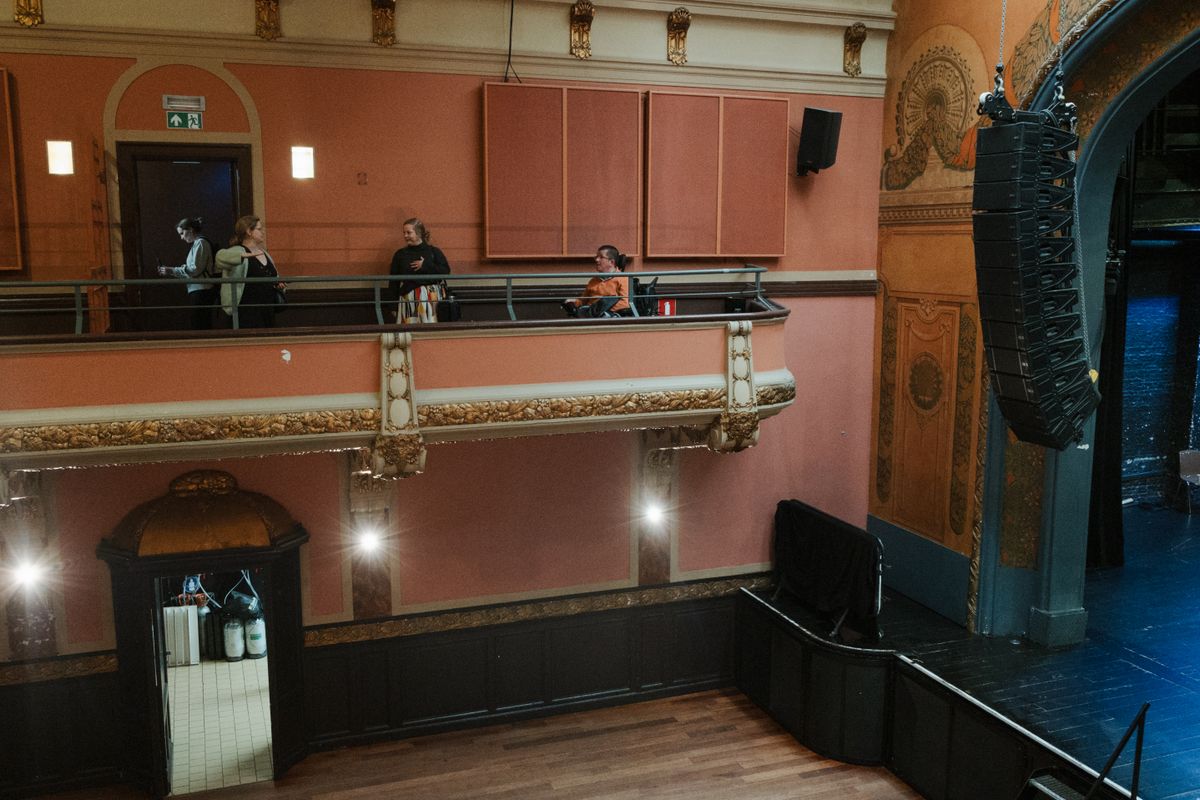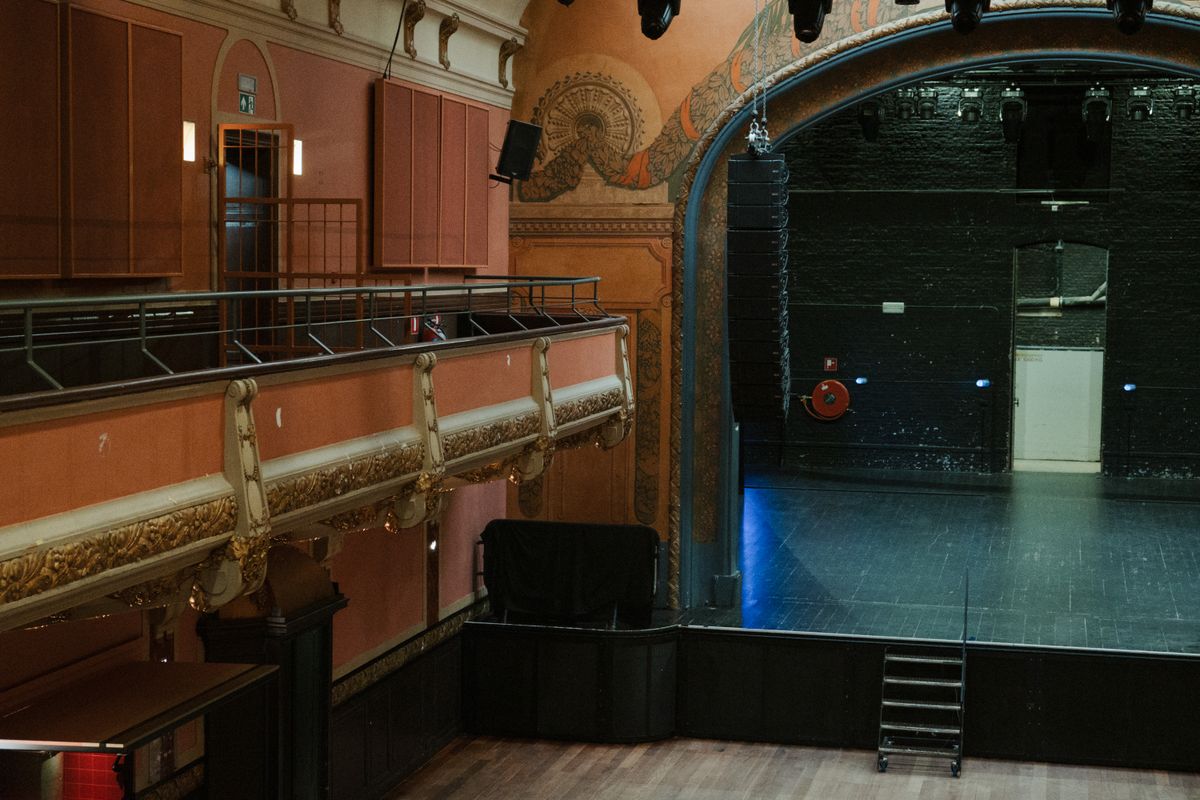FIVE INTERVENTIONS THAT MAKE VOORUIT MORE ACCESSIBLE AND CANDIDACY UNESCO WORLD HERITAGE SITE
De Vooruit opened its doors in 1913, making it one of the oldest arts houses in our country. Since 1983, the building has been protected as a monument by the Flemish Community.
Matthias Belpaire, infrastructure and monument coordinator VIERNULVIER:
"Constant tinkering is being done to the building with four rooms and a grand café to make it as accessible as possible for people with reduced mobility or a visual or hearing impairment. British artist Jessica Tom, who inspires us in our accessibility journey sums it up powerfully: "De Vooruit should be a space where everyone can be themselves."
Recently, these interventions to De Vooruit were carried out:
a lift in the backstage area of the Theatre Hall now makes it possible to accommodate artists and speakers with disabilities on this stage;
a small lift in the access area to the Theatre Hall allows people with reduced mobility to access the Theatre Hall autonomously. Previously, they were dependent on venue staff from VIERNULVIER to assist them in doing so;
in the Theatre Hall, row 17 seats were moved and made removable. Whereas previously people in wheelchairs could only attend a performance from the front row, they can now do so from a seat that many feel is more comfortable;
the Theatre Hall was equipped with sound amplification and audio descriptive technology. A QR code takes visitors to an app that allows them to control the volume of the show via their smartphone. For some performances, visually impaired people can also tune in via the same app to a channel where the performance is explained simultaneously. A professional narrator describes the actions and emotions seen on stage. This is often done after visually impaired people have been introduced to the actors or dancers beforehand and done a feel tour of the set;
in the Concert Hall, people in wheelchairs can now enjoy concerts from the side balcony. This not only offers perfect sightlines, it is also equipped with a separate accessible toilet and fridge, so people no longer have to manoeuvre through the 1,200 concert-goers to get a drink.
These interventions cost €150,000 and were financed by the Flemish Community, the City of Ghent and VIERNULVIER's own funds.
Sami Souguir, alderman for culture City of Ghent:
"As city council, making Ghent's cultural infrastructure accessible is a top priority. We do this with targeted investments in museums and cultural houses. In this way, we ensure that our infrastructure is on point with a view to our candidacy as European Capital of Culture in 2030."
KANDIDAAT UNESCO-WERELDERFGOED
Het toegankelijk maken van kunst en cultuur was dé drijfveer van de Gentse arbeidersbeweging om in 1911 met de bouw te starten van De Vooruit. Naar aanleiding van de Wereldtentoonstelling in Gent in 1913 werd het onder meer door Edward Anseele opgetrokken om de vrijetijdsbesteding van arbeiders te democratiseren.
De Vooruit als socialistisch feest- en kunstencentrum kaderde in de verzuilde Vlaamse maatschappij van voor de Tweede Wereldoorlog. Na de oorlog verloederde het gebouw tot in 1982 de aanzet werd gegeven naar zijn huidige vorm als onafhankelijk kunstencentrum.
Zeven volkshuizen bundelen nu de krachten om gezamenlijk erkend te worden als Unesco Werelderfgoed. Het gaat om:
- The Workers Museum, Kopenhagen, Denemarken
- Paasitorni, Helsinki, Finland,
- Broken Hill Trades Hall, Broken Hill, Australië
- Victorian Trades Hall, Melbourne, Australië
- Edificio de CGT de Argentina, Buenos Aires, Argentinië
- Redhills, Durham, UK
- De Vooruit, Gent, België
Het gaat om zeven iconen van een van de machtigste volksbewegingen uit de recente geschiedenis.
Franky Devos, algemeen coördinator VIERNULVIER:
“Wereldwijd ontstonden in de laatste helft van de 19de eeuw vakbonden en arbeiderspartijen als antwoord op het industrieel kapitalisme. Op veel plaatsen in de wereld bouwden ze volkshuizen. Het waren (en zijn) plaatsen waar voluit ingezet wordt op het wegnemen van drempels bij de vrijetijdsbeleving van een brede groep mensen. Dat is in De Vooruit niet anders. Vorig jaar ontving kunstencentrum VIERNULVIER 313.600 bezoekers voor 522 theater-en dansvoorstellingen, concerten, debatten, rondleidingen en literaire- en nightlife events.”
Het ontwerpdossier wordt eind 2024 ingediend bij het UNESCO hoofdbureau in Parijs. Het definitieve aanvraagdossier volgt begin 2026. We verwachten de erkenning in het najaar van 2027.
De Vlaamse Regering steunt voluit de campagne van VIERNULVIER om De Vooruit te laten erkennen tot UNESCO Werelderfgoed en trekt € 25.000 uit voor historisch onderzoek als onderbouw van het dossier.
Matthias Diependaele, Vlaams minister van Onroerend Erfgoed:
“De Vooruit is een Gents icoon. Het monument staat er al meer dan 100 jaar en kent een rijke geschiedenis. Het gebouw, het Feestpaleis van de arbeidersbeweging, vertelt het verhaal van de industriële revolutie, sociale ongelijkheid, sociale en politieke emancipatie en een groeiende welvaartstaat. Over heel de wereld vind je dit soort Volkshuizen. Samen met onze partners van binnen en buiten Europa willen we deze Volkshuizen als UNESCO werelderfgoed laten erkennen. In totaal gaat het over zeven volkshuizen, verdeeld over zes landen. In Vlaanderen is het gebouw de Vooruit nog een authentiek en overtuigend voorbeeld van de oorspronkelijke opzet van de Volkshuizen. Als alles goed loopt krijgt Gent in 2027 een werelderfgoed erbij in de binnenstad. Naast het belfort en het begijnhof zorgt dit ervoor dat het verhaal van Gent en dat van Vlaanderen tastbaar blijft voor toekomstige generaties.”







